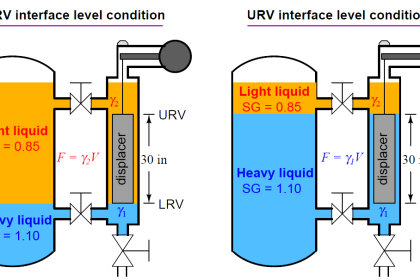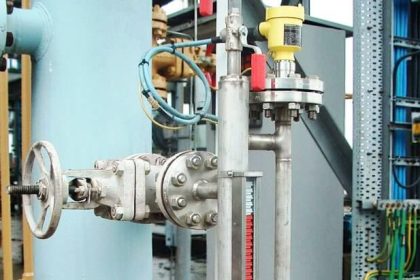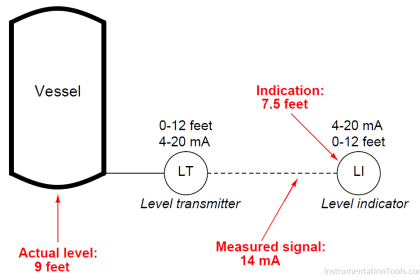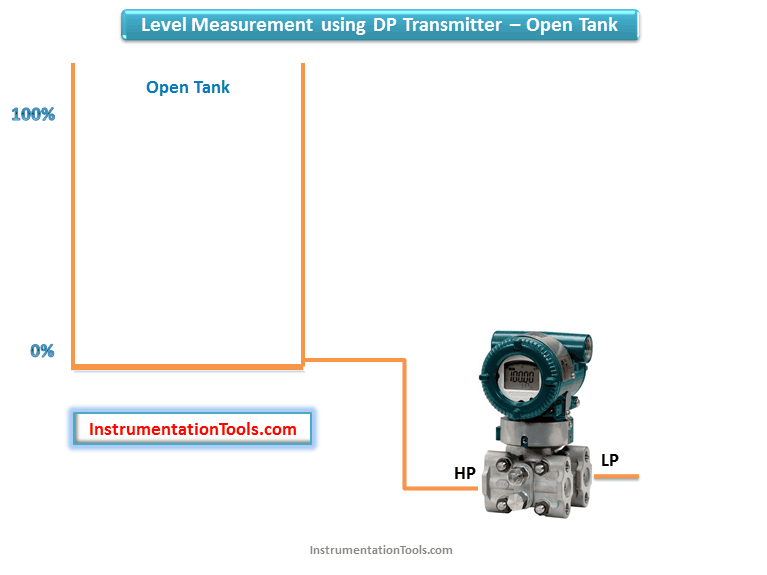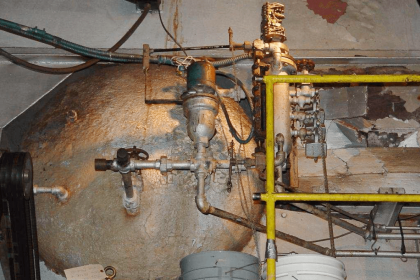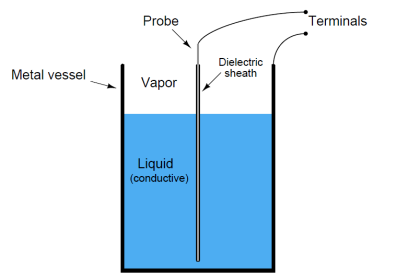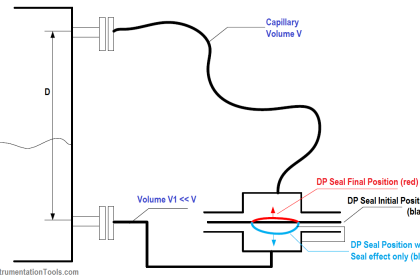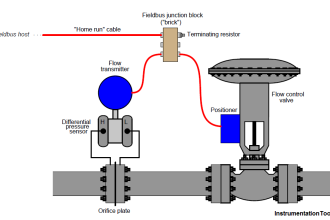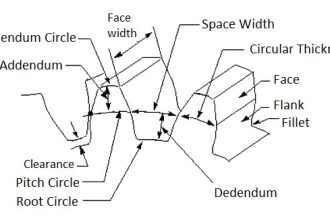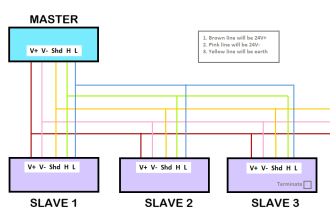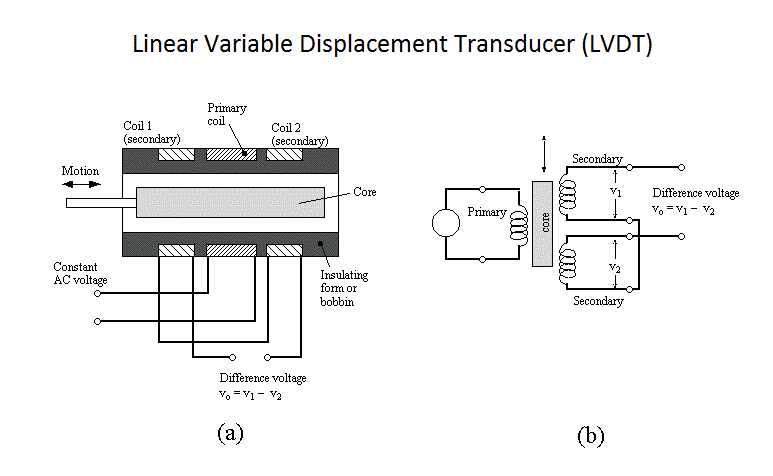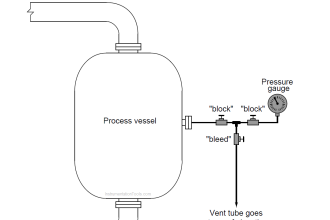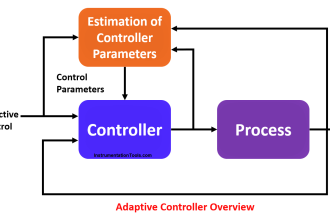Identify characteristics of various level-measurement technologies.
An important tip is to commit to memory the operating principle of each instrument type, and then reason from that basis what each type’s characteristics will be:

Sightglass
Find the below mentioned the questions.
- Can it be used to measure the level of both liquid and solid materials?
- Can it be used to measure liquid-liquid interfaces?
- Does its calibration depend on some fluid property such as density?
- What are the Special advantages?
- What are the Special disadvantages?
Answers
- Liquids only
- Yes, but only if both ports submerged
- No
- Simple and inexpensive
- Manual indication only – no output signal
Float
Find the below mentioned the questions.
- Can it be used to measure the level of both liquid and solid materials?
- Can it be used to measure liquid-liquid interfaces?
- Does its calibration depend on some fluid property such as density?
- What are the Special advantages?
- What are the Special disadvantages?
Answers
- Liquids yes, solids only if retracted by automated winch
- Yes, if float density is set properly
- No
- Relatively simple and inexpensive
- Requires guides and other apparatus to stabilize in a tall vessel; doesn’t work well in turbulent processes
Hydrostatic (DP with direct contact)
Find the below mentioned the questions.
- Can it be used to measure the level of both liquid and solid materials?
- Can it be used to measure liquid-liquid interfaces?
- Does its calibration depend on some fluid property such as density?
- What are the Special advantages?
- What are the Special disadvantages?
Answers
- Liquids only
- Yes, if both ports submerged
- Yes, density!
- Fairly simple and reliable
- DP sensor must withstand process fluid corrosion
Hydrostatic bubbler (dip tube)
Find the below mentioned the questions.
- Can it be used to measure the level of both liquid and solid materials?
- Can it be used to measure liquid-liquid interfaces?
- Does its calibration depend on some fluid property such as density?
- What are the Special advantages?
- What are the Special disadvantages?
Answers
- Liquids only
- Yes, if both ports submerged
- Yes, density!
- Fairly simple and reliable
- DP sensor must withstand process fluid corrosion
Displacer
Find the below mentioned the questions.
- Can it be used to measure the level of both liquid and solid materials?
- Can it be used to measure liquid-liquid interfaces?
- Does its calibration depend on some fluid property such as density?
- What are the Special advantages?
- What are the Special disadvantages?
Answers
- Liquids only
- Yes, if displacer is fully submerged
- Yes, density!
- Simple and reliable
- Susceptible to vibration; displacer may become stuck inside of the cage if the process fouls
Ultrasonic
Find the below mentioned the questions.
- Can it be used to measure the level of both liquid and solid materials?
- Can it be used to measure liquid-liquid interfaces?
- Does its calibration depend on some fluid property such as density?
- What are the Special advantages?
- What are the Special disadvantages?
Answers
- Yes
- No
- Yes, the speed of sound through the transmission media
- No contact with process fluid required
- Requires sharp change in density to function (e.g. layers of foam may interfere with measurement); irregular shapes inside of vessel may cause scattering and/or false echoes
Non-contact radar
Find the below mentioned the questions.
- Can it be used to measure the level of both liquid and solid materials?
- Can it be used to measure liquid-liquid interfaces?
- Does its calibration depend on some fluid property such as density?
- What are the Special advantages?
- What are the Special disadvantages?
Answers
- Yes
- No
- Yes, the speed of light through the transmission media
- No contact with process fluid required
- Requires sharp change in permittivity to function (e.g. certain substances such as wood chips may be difficult to detect); irregular shapes inside of vessel may cause scattering and/or false echoes; permittivity of substance(s) above the measured level will affect its accuracy and may change with the density of that substance
Guided-wave radar
Find the below mentioned the questions.
- Can it be used to measure the level of both liquid and solid materials?
- Can it be used to measure liquid-liquid interfaces?
- Does its calibration depend on some fluid property such as density?
- What are the Special advantages?
- What are the Special disadvantages?
Answers
- Yes
- Yes
- Yes, the speed of light through the transmission media
- Waveguide helps ensure a strong echo signal
- Waveguide must withstand corrosion and other stress from the process fluid; requires significant transitions in permittivity to detect surface and interface levels; irregular shapes inside of vessel may cause scattering and/or false echoes; permittivity of substance(s) above the measured level will affect its accuracy and may change with the density of that substance
Magnetostrictive
Find the below mentioned the questions.
- Can it be used to measure the level of both liquid and solid materials?
- Can it be used to measure liquid-liquid interfaces?
- Does its calibration depend on some fluid property such as density?
- What are the Special advantages?
- What are the Special disadvantages?
Answers
- No
- Yes, if float density is set properly
- No
- Highly accurate measurement of float position (sub-millimeter resolution capability!)
- Susceptible to fouling of float on waveguide rod
Weight (load cells on vessel)
Find the below mentioned the questions.
- Can it be used to measure the level of both liquid and solid materials?
- Can it be used to measure liquid-liquid interfaces?
- Does its calibration depend on some fluid property such as density?
- What are the Special advantages?
- What are the Special disadvantages?
Answers
- Yes
- No, unless total height of liquid is fixed (e.g. using an overflow pipe)
- Yes, if level (height) measurement is desired; No, if mass measurement is desired
- No contact with process fluid required; yields a linear measurement regardless of vessel geometry
- All mechanical stress must be eliminated from vessel
Capacitive
Find the below mentioned the questions.
- Can it be used to measure the level of both liquid and solid materials?
- Can it be used to measure liquid-liquid interfaces?
- Does its calibration depend on some fluid property such as density?
- What are the Special advantages?
- What are the Special disadvantages?
Answers
- Yes
- Yes, so long as probe is fully submerged
- Yes, permittivity of the process liquid for the non-conducting style
- Inexpensive
- Prone to calibration errors due to stray capacitance; irregular shapes inside of vessel may cause nonlinear response
Nuclear
Find the below mentioned the questions.
- Can it be used to measure the level of both liquid and solid materials?
- Can it be used to measure liquid-liquid interfaces?
- Does its calibration depend on some fluid property such as density?
- What are the Special advantages?
- What are the Special disadvantages?
Answers
- Yes
- Yes, if density or other radiation attenuating/scattering properties are sufficiently different between the two liquids
- Yes, density!
- No contact with process fluid required
- Expensive to license and operate; calibration errors may result with fouling of vessel walls
Share your answers & explanation with us through the below comments section.
Read Next:

